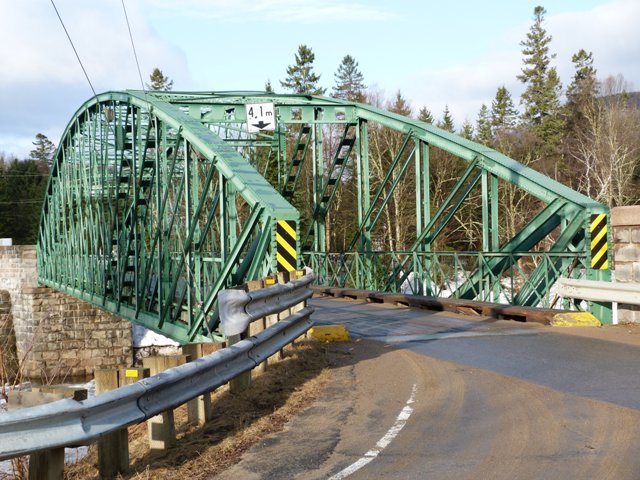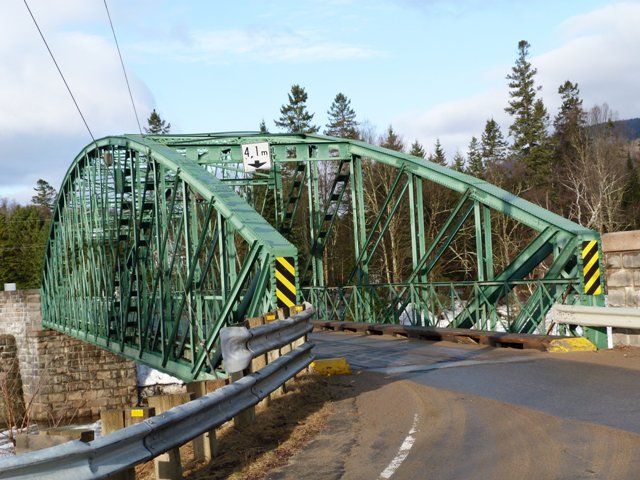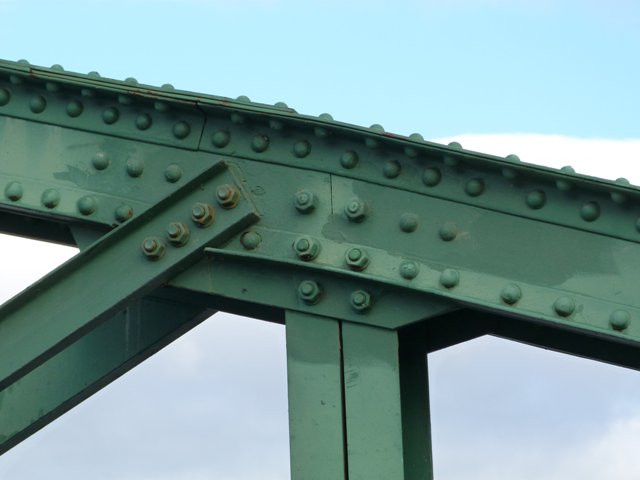We Recommend:
Bach Steel - Experts at historic truss bridge restoration.
BridgeHunter.com Phase 1 is released to the public! - Visit Now
Pont Clark
Clarks Bridge

Primary Photographer(s): Nathan Holth and Rick McOmber
Bridge Documented: April 14, 2011
Saint-Gabriel-de-Valcartier: Capitale-Nationale, Québec: Canada
1891 By Builder/Contractor: Unknown and Engineer/Design: Gérard Macquet
Not Available or Not Applicable
192.0 Feet (58.5 Meters)
192.0 Feet (58.5 Meters)
Not Available
1 Main Span(s)
Not Applicable

View Information About HSR Ratings
Bridge Documentation
Introduction: About Gérard Macquet
In 1887 the Québec government created a program to promote the construction of metal bridges, with the hope of providing better and more durable bridges than the short-lived wooden structures that were being built at the time. The Department of Public Works hired a young Belgian engineer by the name of Gérard Macquet to be the Director of Bridge Construction. Macquet brought with him a European philosophy of bridge construction. Gérard Macquet was the designer of Pont Clark.
In 1887, wrought iron and pinned connections in metal truss bridges were the most common form of metal bridge throughout North America, for reasons of materials cost, as well as the available types of labor and field equipment available. Steel was being used in railroad rails, and so wrought iron was cheaper. Pinned connections were easy for unskilled labor to assemble in the field and eliminated the need for field riveting, which was difficult prior to the development of the handheld pneumatic rivet hammer. Bridge technology development in this period was focused on economy of materials, ease of assembly, and bridge durability. Many bridge builders attempted to develop unique patented construction details and truss configurations in an attempt to build the best bridge. Later, builders found it easiest to stick with standardized materials and construction details. However it was not until the early 1900s that the extremely important transition to steel and riveted connections in trusses was completed.
Using steel and providing riveted connections in truss bridges was not as problematic in Europe, and so in terms of this aspect of technological development, Europe was for many years significantly ahead of North America in terms of bridge construction. There were also a number of design and cosmetic differences that meant that bridges built in Europe often had different truss configurations and built-up beam styles on them compared to North American bridges. Coming from Europe, Macquet brought with him an understanding of the values of steel and riveted connections, and the feasibility of their construction. Macquet advocated for the use of mild steel and riveted connections in truss bridges. As a result, in his position as Director of Bridge Construction, Québec saw steel bridges being constructed on its roads earlier than other places in North America. Macquet's bridges were also noted for their European styling in terms of design.
About Pont Clark
Designed by Gérard Macquet, Pont Clark is a through truss that displays a truss configuration which is called Macquet Parabolic, and is similar to a design sometimes called a "bowstring" in Europe. The design is not found in North America outside of Québec. It is essentially a double-intersection Pratt (Whipple) truss with a polygonal or curved top chord. In the case of Pont Clark, the top chord is polygonal that terminates at vertical end posts. The rarity of the truss configuration, the early use of riveted connections, and the unique philosophy and background of Macquet being embodied in the design of the bridge make this one of the most important historic bridges in Québec.
This bridge presents an interesting comparison to Pont Turcot. Pont Turcot is slightly older and is more strongly European in design, with a curved top chord (not polygonal) and built-up beams that are unlike those produced in North America. In contrast, Pont Clark has a polygonal composition of its top chord which creates the illusion of a curved top chord. Also, the built-up beams use a more traditional style of built-up beam for North America, in particular the lattice on the overhead bracing. Pont Turcot, although closed to vehicular traffic, remains with nearly perfect historic integrity with hardly any alterations or loss of original material. In contrast, Pont Clark has had some alterations, although these alterations have enabled the bridge to continue to serve traffic including trucks and school buses.
2001 Bridge Rehabilitation and Current Condition of the Bridge
In 2001, the bridge was rehabilitated for continued vehicular use. Prior to rehabilitation, the condition of the bridge resulted in a weight limit combination of "18 t - 26 t - 34 t" and a higher weight limit was desired. It should first be noted that even the 18 tonne weight limit is, compared to most 19th Century metal truss bridges in North America, quite high even for a well-maintained bridge. This suggests that Gérard Macquet's forward-thinking may have led him to design bridges for far greater weight limits than many engineers of the period. Following rehabilitation, as of 2011, the bridge has a posted weight limit combination of "26 t - 34 t - 40 t," which is quite impressive. As a historic bridge rated highly by the government, the rehabilitation was required to be conducted with an eye toward maintaining the integrity of the original materials and design, while balancing the need of the bridge to serve traffic including trucks and school buses. The end result as seen today is a bridge that overall retains good historic integrity, particularly in the most significant area: the trusses, while also having a number of alterations that should be pointed out. In particular, the entire flooring system, including floor beams was replaced with modern galvanized steel. A number of deteriorated rivets were replaced with modern high-strength tension-control bolts. Also a couple diagonal members were replaced. Overall, most alterations are combined to the portions of the bridge near or below roadway level. This is typical, and reflects the fact that winter deicing salt and general moisture and dirt get deposited and trapped in these area, causing deterioration. In the future, this type of deterioration can be prevented by carefully maintaining the paint system to prevent rust from forming in the first place, and also engaging in a routine bridge washing program. As of 2011, the bridge appeared to remain in excellent condition. With proper maintenance and repair this bridge can look forward to another century of service.
![]()
Photo Galleries and Videos: Pont Clark
Structure Overview
Original / Full Size PhotosA collection of overview photos that show the bridge as a whole and general areas of the bridge. This gallery offers photos in the highest available resolution and file size in a touch-friendly popup viewer.
Alternatively, Browse Without Using Viewer
![]()
Structure Details
Original / Full Size PhotosA collection of detail photos that document the parts, construction, and condition of the bridge. This gallery offers photos in the highest available resolution and file size in a touch-friendly popup viewer.
Alternatively, Browse Without Using Viewer
![]()
Structure Overview
Mobile Optimized PhotosA collection of overview photos that show the bridge as a whole and general areas of the bridge. This gallery features data-friendly, fast-loading photos in a touch-friendly popup viewer.
Alternatively, Browse Without Using Viewer
![]()
Structure Details
Mobile Optimized PhotosA collection of detail photos that document the parts, construction, and condition of the bridge. This gallery features data-friendly, fast-loading photos in a touch-friendly popup viewer.
Alternatively, Browse Without Using Viewer
![]()
Southbound Crossing
Full Motion VideoStreaming video of the bridge. Also includes a higher quality downloadable video for greater clarity or offline viewing.
![]()
Northbound Crossing
Full Motion VideoStreaming video of the bridge. Also includes a higher quality downloadable video for greater clarity or offline viewing.
![]()
Maps and Links: Pont Clark
Coordinates (Latitude, Longitude):
Search For Additional Bridge Listings:
Additional Maps:
Google Streetview (If Available)
GeoHack (Additional Links and Coordinates)
Apple Maps (Via DuckDuckGo Search)
Apple Maps (Apple devices only)
Android: Open Location In Your Map or GPS App
Flickr Gallery (Find Nearby Photos)
Wikimedia Commons (Find Nearby Photos)
Directions Via Sygic For Android
Directions Via Sygic For iOS and Android Dolphin Browser




